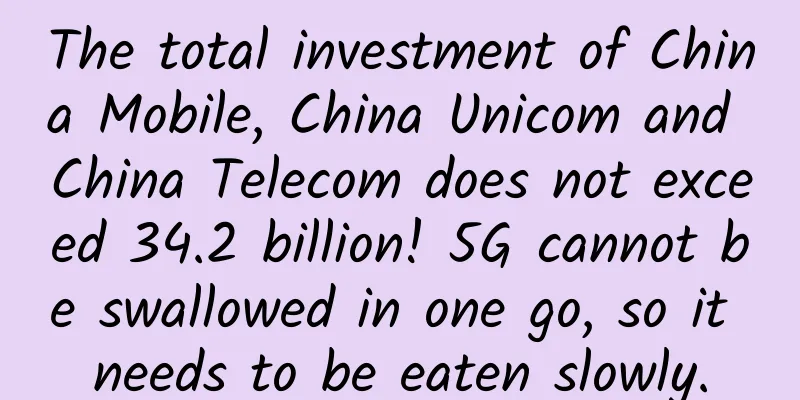The total investment of China Mobile, China Unicom and China Telecom does not exceed 34.2 billion! 5G cannot be swallowed in one go, so it needs to be eaten slowly.

|
As 5G enters its first year of commercial use, the 2019 5G investment plans announced by the three major operators have caused the outside world's enthusiasm to plummet, and the industry has begun to return from impetuousness to rationality.
Recently, the three major operators have successively announced their achievements in 2018. Overall, 2018 was a very successful year. However, compared with the "aggressive" achievements of the three last year, the 5G that was eagerly anticipated by the outside world this year encountered a "late spring cold" and ushered in a "surface slowdown" development. They have all given rigorous and conservative 5G investment plans. Specifically:
Conclusion: The total investment of the three major operators in 5G in 2019 will not exceed 34.2 billion yuan! Compared with the outside world's exaggerated praise for 5G, the progress made by 5G in standards, business, security, etc. last year, and the operators' previous enthusiastic attitude and expectations towards 5G, 5G, which was supposed to open up a trillion-dollar market, suddenly encountered a "late spring cold"? On the surface, 5G development seems to have encountered the dilemma of "slowing down", but is this really the case? The 5G market is too big to swallow in one bite How big will the 5G market be in the future? Previously, the China Academy of Information and Communications Technology predicted in its "White Paper on the Economic and Social Impact of 5G" that by 2030, 5G is expected to drive my country's direct economic output of 6.3 trillion yuan, economic added value of 2.9 trillion yuan, and 8 million jobs. Telecom operators, equipment manufacturers, and friends from various industries are all salivating over this huge piece of cake and looking forward to its accelerated arrival. At the same time, 2019 is also considered the first year of 5G commercialization. Its low latency, high bandwidth and large capacity provide the basic connection capabilities for the Internet of Everything. At this year's Mobile World Congress, a major trend that can be seen everywhere is that 5G has gradually shifted from concept to application, and 5G applications have become more and more specific. For example, the eye-catching Huawei folding screen mobile phone, which breaks the boundary between mobile phones and tablets, or Nubia's α bracelet mobile phone, and the subsequent series of applications such as autonomous driving, remote control, VR/AR, etc. also rely on 5G to drive. From the outside, 5G seems to be accelerating the release of its own capabilities and empowering the industry. However, there are two problems that stand in the way of 5G commercialization. First, 5G network construction needs to cover all areas; second, technological development needs to be constrained by corresponding laws. The significance of full coverage of 5G networks lies in the uninterrupted network services. For example, for self-driving cars, if 5G deployment is only completed in cities, what happens when the car drives out of the city and drives to the suburbs, rural areas or even other remote areas? In addition, technology needs to be adapted to laws and regulations. Taking self-driving as an example, if a traffic accident occurs due to a technical loophole, how is the responsibility determined? Looking at it this way, even if 5G technology is mature, it will be difficult to achieve full commercial use of 5G without these two prerequisites. A preliminary exploration of 5G business models: local driving the whole 2019 is the year of commercialization of 5G. The author believes that 5G is in its infancy and needs to be divided into those who are used first and those who are used later, with those who are used first helping those who are used later.
The above mentioned comprehensive network construction and legal issues. In fact, although these two issues cannot be the real reasons for restricting 5G investment, they have made it clearer that there are fundamental issues restricting the development of 5G. What development path should 5G commercialization follow? In other words, 5G commercialization cannot be achieved overnight, nor can it be achieved overnight. Before 5G, although the change of communication technology led to the change of terminals, and then gave rise to the change of applications, in the final analysis, its ultimate service object is still people. The most significant feature of 5G is that it breaks through the concept of "people connection" and is no longer just for serving people. Compared with 3G/4G, 5G can truly serve both C-end and B-end users. Below, we first explain two concepts, namely 5G public network and enterprise private network. The public network is not difficult to understand, that is, to establish a public 5G network covering the entire area. The enterprise private network is built within the enterprise to achieve seamless coverage of 5G network services within the enterprise. The enterprise private network has two advantages: first, it meets the network services for specific areas of the B-side mentioned above; second, 5G is coming with artificial intelligence, which can give play to the advantages of edge computing, complete data processing in the nearest base station, and meet the efficient processing of enterprise data and data privacy. In other words, building a comprehensive network has another meaning, which is to deploy a continuous network covering the entire area in a specific area. For example, at the robot strategy conference held by Megvii a few years ago, they divided the future application scenarios of 5G and artificial intelligence into specific logistics and warehousing scenarios. By the same token, jumping out of the premise of fully deploying 5G and realizing full deployment of 5G in specific scenarios to test the success of its business model is also an important way to explore the 5G business model. Compared with the 5G network for the consumer side, in the current environment of speed increase and fee reduction, the consumer side has not yet produced revolutionary products, which will not significantly improve the revenue growth of operators. Therefore, when the existing business model is not enough to change the current operating status of operators and the new business model cannot be applied on a large scale, from the overall development of 5G, 5G is divided into first use and later use, and local driving the whole may become an important way for operators to get returns before investing in 5G and reinvest. Money makes a hero fall, 5G network construction proceeds step by step Wei Leping, executive deputy director of the Ministry of Industry and Information Technology's Communications Science and Technology Committee, once said that based on capacity base construction, 5G investment will be 1.5 times that of 4G, and the total 5G investment in the country is expected to reach 1.2 trillion yuan, and its investment cycle may exceed 8 years. In other words, 5G may cause a phenomenon that a man without money cannot make a hero, and a woman without rice cannot make a meal. Not only is it much larger than 4G in terms of volume, but the investment cycle will also be quite long.
According to China Mobile's 2018 financial report, its actual revenue was 736.8 billion yuan, and the growth rate dropped to 1.8% of five years ago. Its own cash flow dropped from 67.981 billion yuan in 2017 to 39.076 billion yuan in 2018. If this is the case for China Mobile, what about China Telecom and China Unicom? The 5G pie is indeed tempting, but without considering the return on investment, we must first consider how to build the network, and even the three major operators have to be cautious about this. As a result, a vicious circle of mutual constraints has formed between 5G network construction, business model exploration, and operator investment/return. Of course, the "negative" 5G investment attitude of the three major operators does not mean a doubt about 5G. This conservative investment may be a precursor to the beginning of 5G. From a national strategic perspective, 5G construction has been elevated to a strategic position in national economic development by the Central Economic Working Group. The country has repeatedly stressed the need to accelerate the construction of 5G networks and new infrastructure such as the Internet of Things, artificial intelligence, and industrial Internet. Therefore, it is not ruled out that the country will provide policy support for 5G construction and help the pace of 5G commercialization. Secondly, from the strategic perspective of the three major operators, 5G is fundamentally different from 3G/4G. In terms of investment, the 5G standard is highly unified, and network sharing is not excluded in the future. At present, Vodafone and O2 have expanded the network sharing agreement and signed some non-binding clauses, including the sharing of 5G networks, which will reduce the cost of operators to deploy 5G to a certain extent and simplify 5G deployment. In addition, Polish operators and Telecom Italia are also vigorously promoting network sharing. In this way, as China is the world's largest 5G market in the future, network sharing will provide a very important way for the three major domestic operators to reduce costs and increase efficiency. In addition, the three major operators are currently taking a wait-and-see attitude towards 5G. Once 5G commercialization shows an optimistic trend, it is not ruled out that operators will dynamically adjust their investment in 5G. It is worth looking forward to that with the further establishment of 5G standards, the issuance of 5G temporary licenses in May, the progress of 5G network phased experiments, and the sale of 5G terminals in the middle of the year, perhaps 5G will usher in a new round of development? In short, 5G is no longer like previous communication technologies. Its market is so large that it needs to be nibbled away slowly rather than swallowed all at once. |
<<: IP address conversion: conversion between numbers and strings
>>: 9 killer apps for edge computing
Recommend
What is the difference between wireless repeater and Mesh? This article will teach you how to use your home network well
At present, people's lives are becoming riche...
HostYun: Los Angeles CN2 GIA line cheap version online, 1GB memory package monthly payment starts at 15 yuan
HostYun recently launched a low-cost package for ...
[Black Friday] spinservers: 10Gbps San Jose/Dallas servers starting at $89/month, 50% off on all hybrid servers, $200 off on high-end servers
The Black Friday promotion of spinservers continu...
Silicon multiplexer chips will drive the development of 6G next-generation communications
A new design of ultra-small silicon chip, called ...
SF Express's Liu Zhixin: Artificial intelligence helps logistics upgrade
[51CTO.com original article] On July 21-22, 2017,...
Huawei Cloud releases three types of six computing instances to build stronger cloud computing capabilities
On December 15, Huawei Cloud held its latest priv...
DesiVPS: $110/month-2*E5-2670v2/64GB/1TB SSD/30TB@10Gbps/San Jose data center
DesiVPS is a foreign hosting company headquartere...
What is the current status of 6G and when will it arrive?
6G will bring many improvements in many areas, bu...
5G technology: enabling the Internet of Things and ultra-high-speed connectivity
In the digital age where seamless connectivity an...
API has become the biggest risk exposure in data security. How to win the “data protection war” in the digital age?
Nowadays, data has become an emerging production ...
DiyVM: Japan Osaka/US Los Angeles/Hong Kong Shatin CN2 line 2G memory VPS monthly payment starts from 50 yuan
DiyVM has recently made major changes to the webs...
The three major operators secretly cut 5G prices. Users: The private 9-yuan package is still more attractive
According to customer service, the 5G network tra...
HostNamaste: 128G-8TB large hard disk VPS monthly payment starts at $4.99, 2G memory special VPS annual payment starts at $36, Los Angeles & Dallas data centers
HostNamaste recently promoted special annual VPS ...
HostXen charges 100 yuan and gets 20 yuan, new users get 50 yuan for registration, US/Japan/Singapore/Hong Kong VPS 6GB memory starts from 70 yuan/month
HostXen is continuing its year-end promotion this...
CMIVPS: VPS hosting with 30% off annual payment and 20% off monthly payment, large bandwidth/direct connection in Hong Kong
CMIVPS released a new discount plan for blog read...









